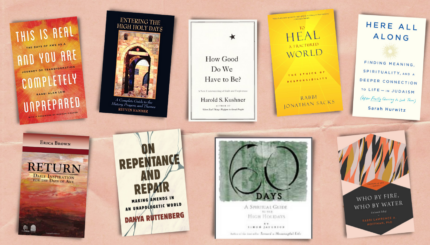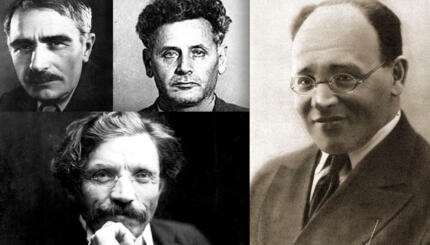“America I’m putting my queer shoulder to the wheel,” Allen Ginsberg declared at the conclusion of his 1956 poem “America.” Ginsberg was indeed putting his shoulder to the wheel, singing of America, and to America, even as it proved occasionally inhospitable to his life and art.
Ginsberg (1926-1997) was one of the founding members of the Beat movement, alongside novelists Jack Kerouac and William S. Burroughs and poets Lawrence Ferlinghetti and Jack Micheline. The Beats were anti-establishment with a hunger for experience and a desire to rewrite American letters to include themselves. They stood in opposition to what they saw as the stultifying consensus of 1950s America.
Ginsberg was born in 1926 in New Jersey, and spent his childhood in Paterson–home of poet William Carlos  Williams, who would eventually serve as his mentor and write an introduction to Ginsberg’s chapbook Howl and Other Poems (1956). Ginsberg attended Columbia University on a scholarship granted by the YMHA (Young Men’s Hebrew Association) of Paterson. In New York, Ginsberg met other young poets and artists who would eventually become part of the Beat movement, including Lucien Carr, Gregory Corso, and Neal Cassady. After college, Ginsberg moved to San Francisco, where poets like Snyder and Kenneth Rexroth were already working.
Williams, who would eventually serve as his mentor and write an introduction to Ginsberg’s chapbook Howl and Other Poems (1956). Ginsberg attended Columbia University on a scholarship granted by the YMHA (Young Men’s Hebrew Association) of Paterson. In New York, Ginsberg met other young poets and artists who would eventually become part of the Beat movement, including Lucien Carr, Gregory Corso, and Neal Cassady. After college, Ginsberg moved to San Francisco, where poets like Snyder and Kenneth Rexroth were already working.
Ginsberg crafted a style all his own, borrowing liberally from Walt Whitman’s romanticism while writing sympathetically of his own life, including his homosexuality, the tortured romantic and personal lives of his friends, and his drug use. “I saw the best minds of my generation destroyed by/madness, starving hysterical naked,/dragging themselves through the negro streets at dawn/looking for an angry fix,” begins Ginsberg’s famous “Howl.” The poem goes on to serve as a collective autobiography of the poet and his friends, and a condemnation of the military-industrial Moloch of its time. Ginsberg’s poetry revolved around his use of extended lines, which often move to a jazzy rhythm, and the poet gave credit for his style to both the jazz music he loved and the legendarily talkative Jews of his own youth.

Help us keep Jewish knowledge accessible to millions of people around the world.
Your donation to My Jewish Learning fuels endless journeys of Jewish discovery. With your help, My Jewish Learning can continue to provide nonstop opportunities for learning, connection and growth.
“Howl” led to an obscenity trial in 1957, which resulted in a famous victory for Ginsberg and the defenders of the artist’s First Amendment right to freedom of expression. “Poets are damned but they are not blind, they see with the eyes of angels,” wrote Williams in the introduction to Howl and Other Poems. “This poet sees through and all around the horrors he partakes of in the very intimate details of his poem.”
Whitman’s poetry was the obvious model for Ginsberg, who updated the generous, lyrically abundant, open-hearted style of “Song of Myself” for another era. In part, this was done by Ginsberg’s openly acknowledging the homoeroticism Whitman could only nod to parenthetically—”queer shoulder” and all. But there was also a savvy mingling of Whitman’s universalism with Ginsberg’s own particularism. Ginsberg wanted to be both an exceptional poet and no one other than himself—unabashedly intellectual, gay, and Jewish. Ginsberg’s Jewishness, too, was of a universal kind, less attuned to tradition than a pan-historical embrace of the spiritual. In the 1977 poem “What’s Dead,” from Plutonian Ode, a reference to Moses is accompanied by one to Jesus and Buddha–and Elvis Presley and Groucho Marx, as well.
Ginsberg’s poetry conjoined disparate traditions, mingling the religious and the secular, the higher realms and the lower. The 1974 poem “Jaweh and Allah Battle” tackles this union of Judaism and spiritualism, acknowledging “Israel’s tribes worshipping the Golden Calf” and “Zalmon Schacter Lubovitcher Rebbe” before settling on a mantra of pan-religious harmony: “JAWEH AND ALLAH SENT ME HERE!/Abraham will take me to his bosom!/Mohammed will guide me to
paradise!/Christ sent me here to be crucified!/Buddha will wipe us out and destroy the world.” The poem ends with a recitation of the prayer, and a partially Jewish reference to the conclusion (“Shantih! shantih! shantih!”) of T. S. Eliot‘s “The Waste Land,”: “SHALOM! SHANTIH! SALAAM!”
“Kaddish,” (1961) one of Ginsberg’s most beloved poems, was a tribute to his mother, a sort of English translation and interpolation of the ancient Jewish prayer for the dead, as filtered through things like Ray Charles blues, the Yiddish theater, and Emily Dickinson’s horses. Ginsberg’s mother, who had wrestled with mental illness all her life, and had brought her son to her therapy appointments when he was a child, died in 1956. Without the ten Jewish men necessary for a minyan, no was recited for her at the funeral. “Kaddish” the poem is a replacement for that missed opportunity, and a tribute to his mother’s misbegotten life.
The lines of “Kaddish” overflow their bounds, coming near to short story as the language echoes Whitman and the skittering rhythm of Dickinson. Ginsberg compares his mother Naomi to the Biblical figure of the same name, and her death leaves “Svul Avrum–Israel Abraham–myself–to sing in the wilderness/toward God–O Elohim!” Unstintingly depicting his mother’s years of torment, he also sings of a peace distinctly not of this world: “There, rest. No more suffering for you. I know where you’ve gone, it’s good.”
Ginsberg was a man of contradictions–a devotee of Eastern mysticism who wrote insightfully about Jewish history, a populist poet who fell in line with the tradition of William Blake and William Carlos Williams. East and West, high and low, Ginsberg defined the unity of opposites that represented the best of modern American poetry. His Judaism was a fixed star in the rotating spheres, surrounded by Buddha, Mohammed, jazz musicians, and the “angel-headed hipsters,” of “Howl.”


